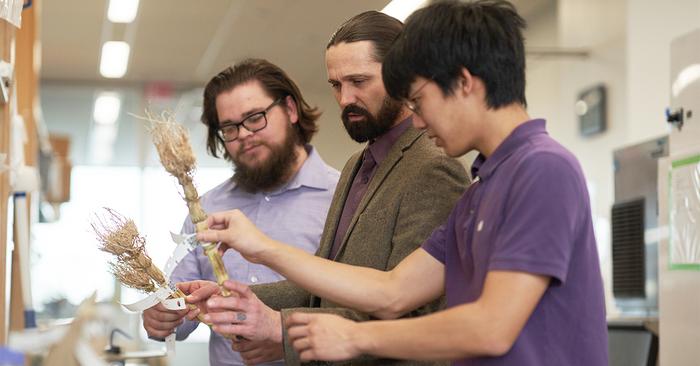ST. LOUIS, MO, AUGUST, 14, 2024 – Christopher Topp, PhD, Member and Principal Investigator of the Danforth Plant Science Center and his lab members Marcus Griffiths, PhD and Kong Wong, PhD, have teamed up with colleagues at the University of Illinois Urbana-Champaign, Kaiyu Guan, PhD, Bin Peng, PhD, and Sheng Wang, PhD, to explore the impact of cover crops on soil health and corn production to improve agriculture sustainability. The research findings will be used to develop tools to help farmers make decisions about when, where and what type of cover crops could be beneficial. A $650,000 award grant from the National Institutes for Food and Agriculture will support the research project.

Credit: Donald Danforth Plant Science Center
ST. LOUIS, MO, AUGUST, 14, 2024 – Christopher Topp, PhD, Member and Principal Investigator of the Danforth Plant Science Center and his lab members Marcus Griffiths, PhD and Kong Wong, PhD, have teamed up with colleagues at the University of Illinois Urbana-Champaign, Kaiyu Guan, PhD, Bin Peng, PhD, and Sheng Wang, PhD, to explore the impact of cover crops on soil health and corn production to improve agriculture sustainability. The research findings will be used to develop tools to help farmers make decisions about when, where and what type of cover crops could be beneficial. A $650,000 award grant from the National Institutes for Food and Agriculture will support the research project.
The research team will conduct multi-year field trials of 12 cover crop species that integrate with corn production, and use root phenomics, cutting-edge sensing technologies, and machine-learning enabled agroecosystem modeling to gain an improved understanding of the variation for root traits that exists among diverse cover crop species and their influence on soil and cash crops.
“The major goal of the project is to fill key gaps in the foundational knowledge base of cover crop plant species that currently hinder their efficacy and farmer adoption,” said Topp. “Roots are the interface of the plant with soil, but there is a limited understanding of cover crop root system traits and their empirical effects on soil health and cash crop productivity.”
Cover cropping has been largely considered a major conservation approach to improve ecosystem services for sustainable agriculture. With current adoption rates low across US farmlands, extensive investments from government and private sectors have strongly encouraged farmers to employ cover crops. These efforts will be bolstered by an increased understanding of cover crop root system traits and their effect on soil and cash crops, especially across the spectrum of cover crop species diversity that will be needed to maximize benefits in many different environments and cropping systems.
“What’s unique about this project is that we will combine the unprecedented capability of the Danforth Center’s root phenotyping with our advanced modeling capability at the University of Illinois, aiming to significantly deepen our understanding of cover crop root diversity and their impacts on plant and soil. Our modeling thus can extrapolate the findings and implications to the broader geography across the Midwest to inform better practices of cover crop,” said Guan, lead principal investigator at the University of Illinois Urbana-Champaign and director of the Agroecosystem Sustainability Center.
“Creating a better understanding of the impact of cover crops will help farmers be more informed about selecting cover crops that maximizes both yield and ecosystem benefits and thereby supports widespread adoption of cover crop management practices in the US,” Topp added.
About the Donald Danforth Plant Science Center
Founded in 1998, the Donald Danforth Plant Science Center is a not-for-profit research institute with a mission to improve the human condition through plant science. Research, education, and outreach aim to have an impact at the nexus of food security and the environment and position the St. Louis region as a world center for plant science. The Center’s work is funded through competitive grants from many sources, including the National Science Foundation, National Institutes of Health, U.S. Department of Energy, U.S. Agency for International Development, and The Bill & Melinda Gates Foundation, and through the generosity of individual, corporate, and foundation donors. Follow us on Twitter at @DanforthCenter.
About Agroecosystem Sustainability Center: The Agroecosystem Sustainability Center was founded in 2021 to lead global efforts in harmonizing sustainable food production with thriving ecosystems. The Center strives to revolutionize agricultural systems through research, collaboration, and engagement, bridging science and practice for agricultural productivity and ecosystem sustainability. Centered in the heart of Midwest on the campus of the University of Illinois Urbana-Champaign under the umbrella of both the College of Agriculture, and Environmental Sciences (ACES) and the Institute of Sustainability, Energy, and the Environment (iSEE), ASC is positioned at the critical intersection of academia, industry, policy, and on-the-ground practice. ASC is creating a diverse and dynamic hub for driving change and is committed to transforming its research into practical and scalable solutions, fortifying our ecosystems, bolstering farm profitability, and empowering agricultural systems to proactively mitigate and adapt to the realities of climate change.
###
Media contact: Karla Roeber, kroeber@danforthcenter.org



